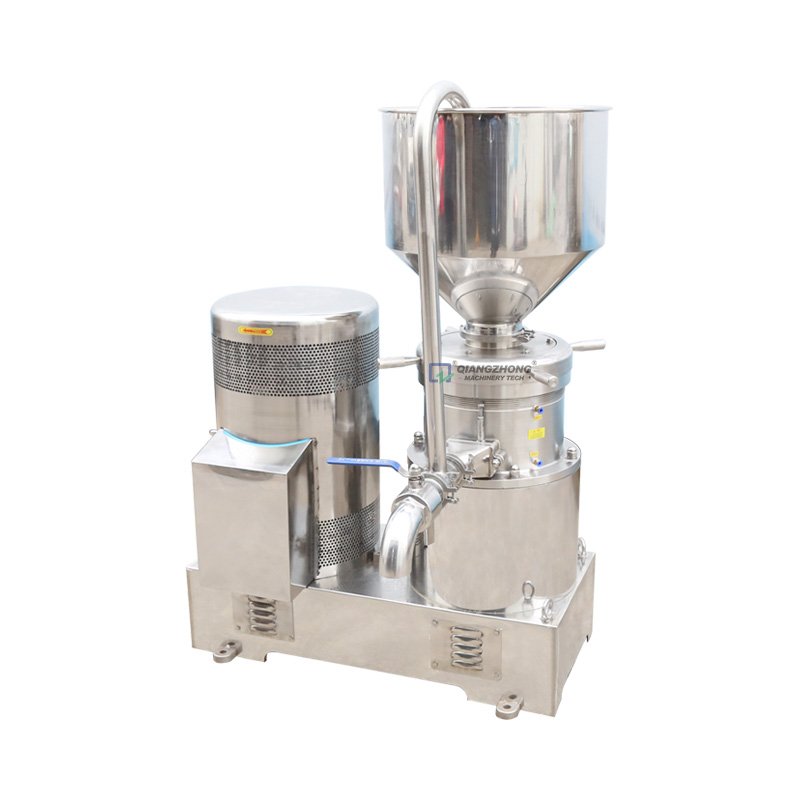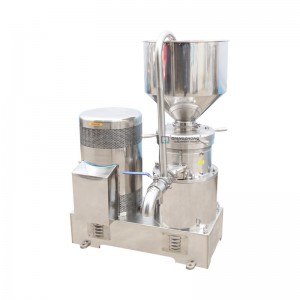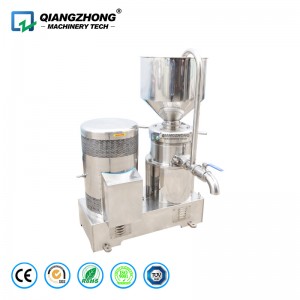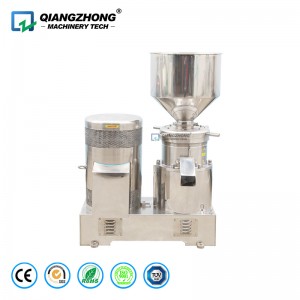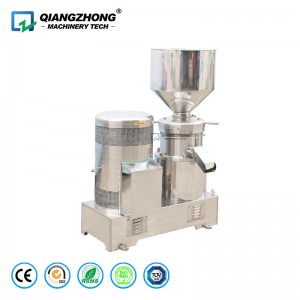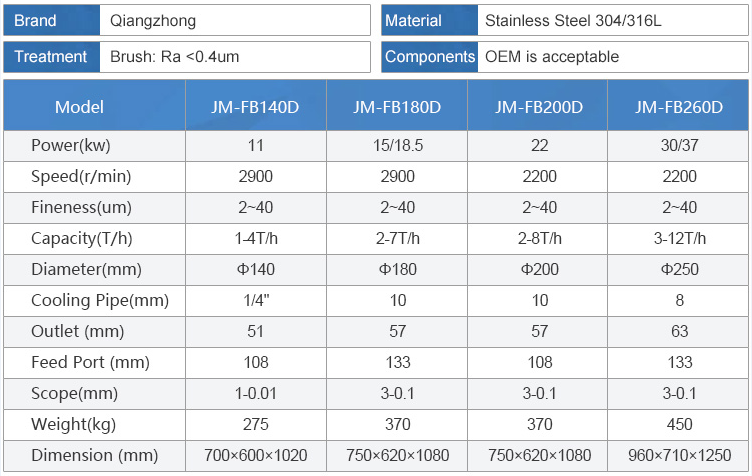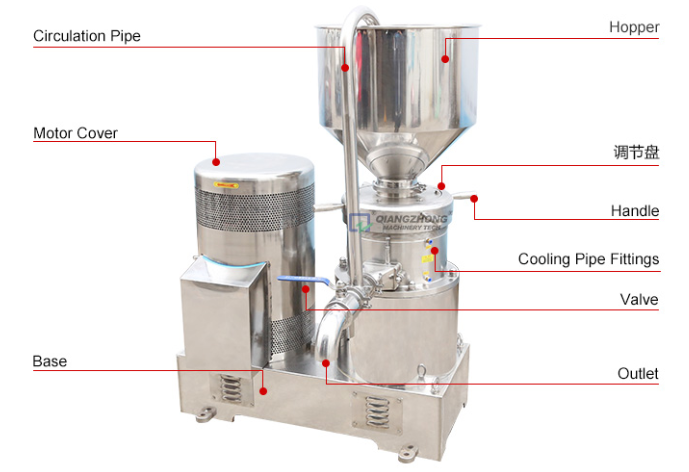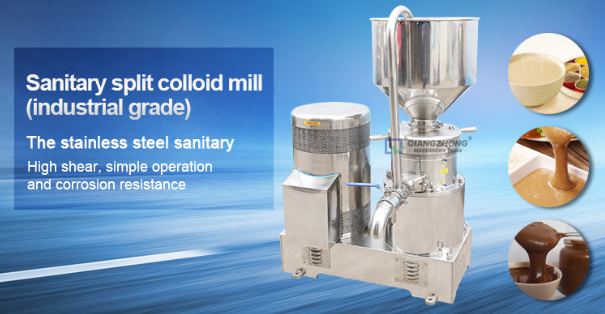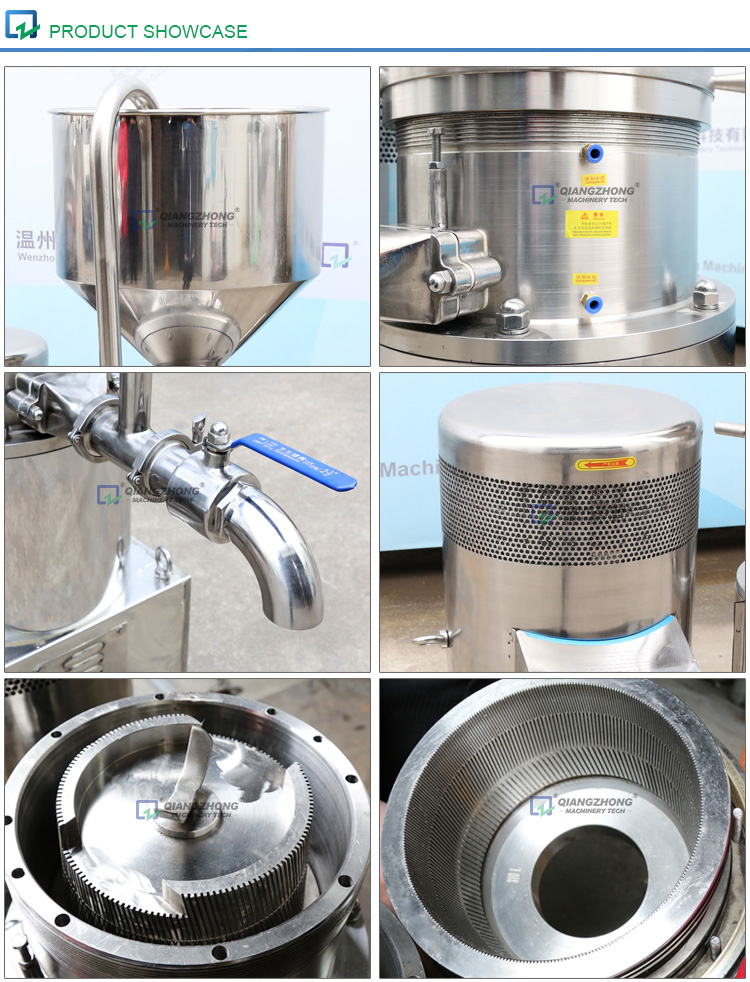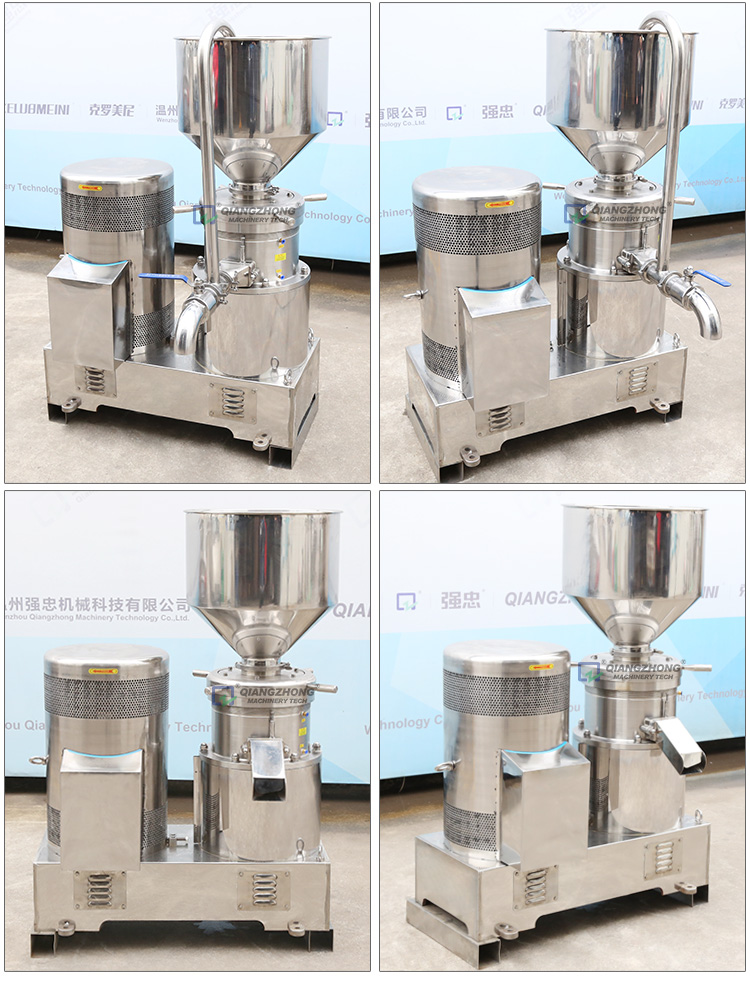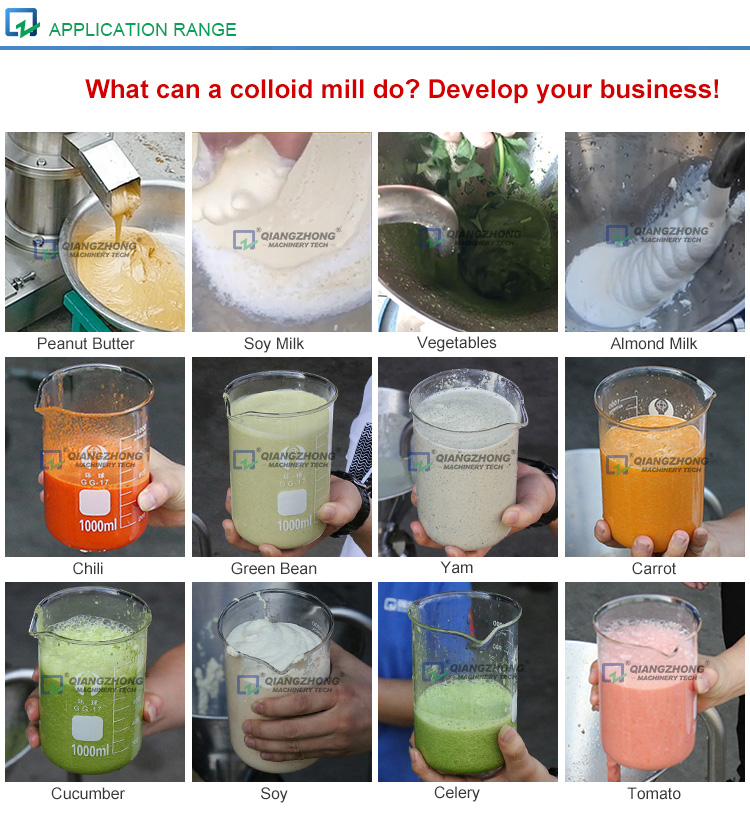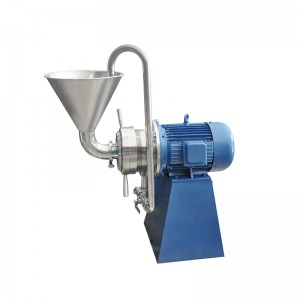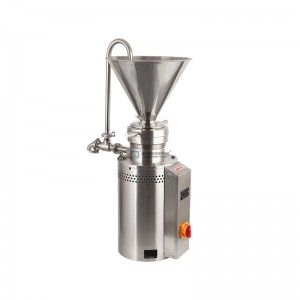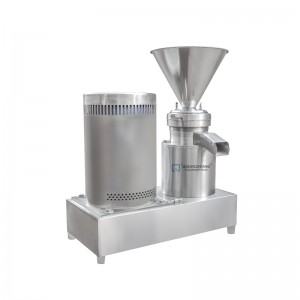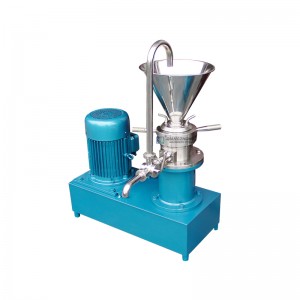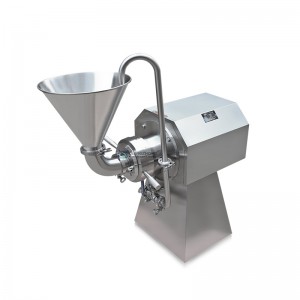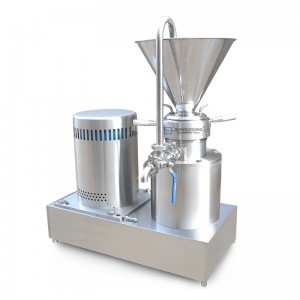Sanitary split colloid mill (industrial grade)
We specialize in manufacturing colloid mills, so we understand your needs!
Stainless steel body, high material fineness, high production efficiency and small footprint
HOW TO CHOOSE A SUITABLE COLLOID MILL?
Check model no : The model no. of a colloid mill shows its structure type and diameter (mm) of grinding disc, which determines capacity.
Check capacity: the capacity of a colloid mill varies greatly according to materials of different density and viscosity.
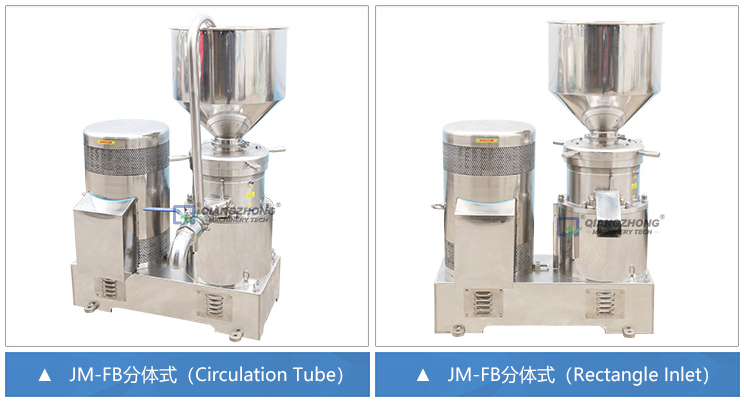
Circulation Tube: suitable for low-viscosity materials that need recycling and reflux for grinding, such as soy milk, mung bean drinks, etc.
Rectangle Inlet: suitable for high and medium viscosity materials that don’t need reflux or grinding, such as peanut butter, chili sauce, etc.
PRODUCT PARAMETERS
Note: The type without machine seal is mainly appliable for processing materials of high concentration or sauce materials such as peanut butter, tahini, animal meat, fish, vegetables, etc.
Note: The type with (double-end) mechanical seal can be connected to pipes for continuous multi-circulation, and the head is about 4 meters.
PRODUCT STRUCTURE
Colloid mill is a processing machine of fine grinding and crushing fluid materials, mainly consist of motor, adjust unit, cooling unit, stator, rotor, shell and etc, widely used in various industries.
1.Both rotor and stator are made of stainless steel, the rotor rotates at high speed and the stator keeps static, which makes materials passing the toothed bevel bear great force of shear and friction.
2.There is a pair of conical rotor and stator rotating at high speed inside a colloid mill. When materials pass the gap between the stator and rotor, they bear great force of shear, friction, centrifugal force and high-frequency vibration, finally making materials ground, emulsified, homogenized and dispersed.
3.It’s high efficiency of grinding ultra-fine particles by force of shear, grinding and high-speed stirring. And crush and grinding by relative movement of the disc tooth-shaped bevels.
Colloid Mill is an ideal wet-crushing equipment. Materials are ground, emulsified, crushed, mixed, dispersed and homogenized under forces of high-frequency vibration and high-speed vortex.
WORKING PRINCIPLE
The basic work principle of colloid mill is that fluid or semi-fluid materials pass the gap between fixed tooth and rotation tooth which are relative high-speed interlocking to make materials bear strong shearing force, frictional force and high-frequency vibration force. Grinding is by the relative motion of toothed bevels, one rotates at high speed, the other keeps static. In that case, materials passing the toothed bevels are greatly sheared and rubbed. At the same time, those materials are under forces of high-frequency vibration and high-speed vortex, which make them ground, emulsified, crushed, mixed, dispersed and homogenized, finally fine finished products are achieved.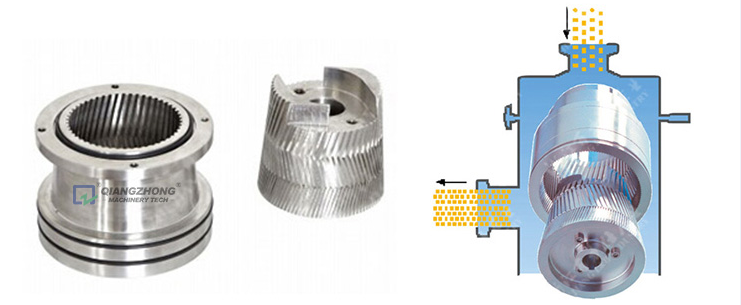
Rotation Disc and Static Disc High Shear
High Speed 2,900RPM to ensure the quality of grinding materials.
Q&A
Question: Can the colloid mill grind corn, millet, soybeans, mung beans, red beans, rice and other grains? If yes, how fine can it be? What is the output?
Answer: 1. Fresh corn (without water) can be ground for each model, and the grinding effect is better after adding water. The specific output is based on different models, please consult our sales staff for details.
2.The rice cannot be ground by adding water directly, but the rice that can be crushed by hand after soaking for a long time can be ground. It is recommended to add more water for grinding;
3.Regarding mung beans, red beans, mung beans and soybeans, it is recommended to soak them for a long time before grinding. The fineness of corn, red beans and mung beans after grinding can reach below 300 mesh, and the fineness of soy beans after grinding is about 80-150 mesh.
The colloid mill is a fine grinding equipment, mainly used for secondary processing of materials. The higher the hardness of the material itself, the more difficult it is to be ground, and the greater the impact on the service life of the equipment. Different materials have different grinding fineness. If you need technical support, please consult our sales staff.
Question: Can the colloid mill grind bones?
Answer: The colloid mill cannot grind hard objects such as bones. The material is easy to get stuck in the cavity, wear the grinding disc, and cause the motor to load. Please do not do that. Otherwise, it may cause the equipment damage, that is man-made damage and not covered by the warranty.
Question: Can the colloid mill grind seafood? What is the output? How fine is it?
Answer: The colloid mill can grind seafood. Since seafood contains salt, its chlorine content is relatively high, and it is corrosive to metals. It is recommended to choose stainless steel 316L with better corrosion resistance for colloid mills. Stainless steel 304 has weak corrosion resistance and is easy to rust. Before grinding, it is recommended to compare the size of the seafood with the size of the hopper port of the colloid mill. If it is easy to block the hole, you need to choose a screw feeder, and better cut the seafood into small pieces to prevent blocking the feeding port, unable to enter the cavity, and cannot be ground. If you need more technical support, please contact us. Note: The flow data on the parameter table is based on the flow of water, not the actual material output.
Question: What is the difference between the split type and the vertical type of the colloid mill? Answer: Their functions are the same, and their models of the same specifications have the same output. But they are different in appearance and structure. The motor of the split colloid mill is installed on the side, even after the equipment is working for a long time, the seal of its cavity is aging, causing liquid leakage, and it will not cause damage to the motor. The motor of the vertical colloid mill is installed directly and vertically at the bottom. If liquid leakage occurs, the motor may be easily short-circuited and cause damage to the motor. The split type has relatively better performance and higher price, but the vertical type is economical and more cost-effective. You can choose the most suitable type and model according to your budget and actual needs.
Question: Can the colloid mill handle high-viscosity materials? Such as honey, oyster sauce, glue?
Answer: High-viscosity materials can be directly discharged by the colloid mill, but it is necessary to consider the effect of high temperature on the materials. It is not recommended to use a colloidal mill for honey processing, because the temperature of the material is easy to rise during the processing, and high temperature will affect the taste. Oyster sauce can be processed with a colloid mill, but the higher power models should be chosen for recycling materials.
Question: Can the colloid mill solve the problem of agglomeration of materials, such as protein powder, starch, salt in oyster sauce or MSG?
Answer: Yes, no problem.
Question: Can the colloid mill grind chili/pepper?
Answer: Yes. It is recommended to chop the chili/pepper first, the smaller the better, and add a screw feeder at the inlet of the colloid mill. It is best to remove the chili seeds, otherwise the seeds will easily enter the groove of the gear and cannot be ground. If so, there are still many unprocessed chili seeds in the final product of chili sauce.
Question: Can the colloid mill grind vegetables? Can you grind fruits, such as pipa, grapes, and apples?
Answer: Vegetables: Vegetables with high water content are recommended to be finely chopped first, the finer the better. A screw feeder is added to the feed port of the colloid mill, and the material can be processed without adding water. But vegetables with low water content and high fiber, such as celery, shiitake mushrooms, kelp; bamboo shoots, water spinach, cabbage, carrots, seaweed, etc., need to be added with water, the more the better, and the higher model of the colloid mill the better grinding performance; (For low fiber vegetables, the theoretical grinding fineness can reach 200 meshes. High-fiber vegetables cannot be completely ground, there will be a lot of fibers in the finished product);
Fruits: It is recommended to chop the fruit first. If the fruit has strong fluidity after crushing, such as oranges, apples, small tomatoes, pears, watermelons, pipa, and grapes, you can grind them in a circular tube. If the fluidity is poor after crushing, such as durian and banana, add some liquid first and then start grinding if adding liquid is allowed to ensure the strong fluidity. If it is adding liquid is not allowed, you need to use the square outlet, and if there is any nucleus, try to remove it first. Apples, pears and watermelons do not need to be pitted, but for fruits with large pits, they must be pitted first. In addition, fruits, especially fruits with poor fluidity, should avoid high temperatures during the grinding process, so as not to affect the taste.
Question: Can the colloid mill grind peanuts, almonds, cocoa beans, sesame and other products? How fine is it? What is the output?
Answer: The colloid mill can grind materials with high oil content, including peanuts, almonds, cocoa beans, cashews, sesame, etc. They need to be roasted or fried first, and the feed port needs to be with the screw feeder, and the applicable models should be with at least a 4kw motor. The output of different models is quite ditferent, please consult our sales staff for details.
Colloid Mill is a second generation of wet ultra-particulate processing equipment Suitable to grind, homogenize, emulsify, disperse and mix various types of emulsion
• Sanitary food-grade stainless steel. Except motor part, all contact parts are made of stainless steel, especially both dynamic grinding disc and static grinding disc are reinforced, making them better properties of corrosion-resistance and wear-resistance. In that case, the finished materials are non- pollution and safe.
•Colloid mill is an ideal equipment for processing fine materials with features of compact design, elegant appearance, good seal, stable performance, easy operation and high production efficiency.
•The motor and the base are separate in the split colloid mill, ensuring good stability, easy operation and a long service life of motor, furthermore it avoids material leakage to prevent motor from burning. It employs labyrinth seal, no wear, corrosion-resistance and less failure. Driving by pulley, it can change gear ratio, increase speed and make materials crushed finely.
•The vertical colloid mill solves the problem that small colloid mills couldn’t work continuously for a long time due to insufficient power and poor sealing. The motor is 220V, its advantages include compact overall structure, small size, light weight, reliable sealing structure and long hours of continuous work, especially suitable for small businesses and laboratory.
•How to know the capacity of a colloid mill ? The flow varies greatly according to materials of different density and viscosity. For example the flow of viscous paint and thin dairy fluids can be different more than 10 times on the same colloid mill.
• Capacity depends on concentration and viscosity of materials ? A colloid mill mainly consists of a motor, grinding parts, driving and base part. Among them, dynamic grinding core and static grinding core are key parts. So you may need to choose different models according to nature of materials.
• Various colloid mill are small vibration, work smoothly and no need foundation.
MORE ABOUT COLLOID MILL
How to install a Colloid Mill:
•Please make sure the colloid mill is completely disinfected and cleaned before first usage.
•First, install hopper / feed pipe and discharge port / discharge circulation tube and then connect cooling pipe or drain pipe. Please do not block the discharge port to ensure materials discharge or cycle.
•hstall power starter, ammeter and indicator. Turn on power and make the machine work, and then judge the direction of motor, the right direction should be clockwise when watching from the feed iniet.
•Adjust the grind disc gap. Loose handles, and then turn adjustment ring clockwise. With one hand deep into the rectangle port to rotate motor blades, and stop it immediately when there is friction on adjustment ring. Next, re-adjust the ring to make sure grind disc gap is larger than the aligned figure based on meeting the fineness of processing materials. This will ensure a longer life of grinding blade. Finally, turn the handle clockwise, lock the ring to make the grinding gap is fixed.
•Add cooling water, turn on the machine and put materials into operation immediately when the mschine is on normal operation, please not allow the machine to idle for more than 15 seconds.
•Pay attention to motor loading, please reduce feeding materials if it is overloaded.
•Since colloid mill is a high-precision machine, working at high speed, grinding gap is minimal, any operator should strictly operate the machine according to the operation rule. If there is any fault, please immediately stop operation and shut down the machine, only re-operate the machine once troubleshooting is completed.
•Do remember to clean the colloid mill thoroughly every time after use to prevent any remains that may lead to mechanical seal adhesion and leakage.
Why does the grinding head loose ?
Correct rotation direction of grinding head is counterclockwise (an arrow illustrates on themachine). If the grinding head works reverses (clockwise), cutter head and materials will collide with each other, leading to threads loosen in the reverse direction. As service time increases, the thread of the cutter head will fall off While if grinding head rotates counterclockwise (the correct direction of rotation), the thread will be tighter and tighter with conflict of materials, the cutter won’t drop. It is suggested that if colloid works reverse when you turn on the machine, please immediately shut it down because if working reversal for long time, the cutter will loose.
Precautions:
Please make sure that quartz, broken glass, metal and other hard objects are not mixed in processing materials, better filter the materials in advance, avciding any damage to rotation disc and static disc.
Right way to adjust the gap between the grinding discs:
locse handles counterclockwise, and then turn adjustment ring clockwise. With one hand deep into the rectangle port to rotate motor blades, and stop it immediately when there is friction on adjustment ring. Next, re-adjust the ring to make sure grind disc gap is larger than the aligned figure based on meeting the fineness of processing materials. This will ensure a longer life of grinding blade. Finally, turn the handle clockwise, lock the ring to make the grinding gap is fixed.
Disassembly Instructions:
1 .Remove hopper counterclockwise, then rotate disc handle counterclockwise, release static disc
2.Pull up the static disc
3.Disassemble V-shape feeding blade counterclockwise.
4.With a screw to pull out of rotation disc, disassembly is completed.
Please note: assembly steps are on the contrary.

